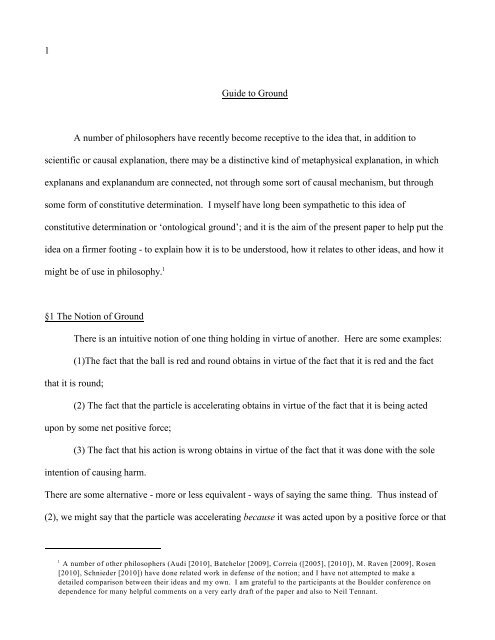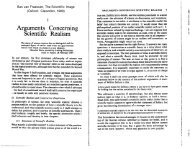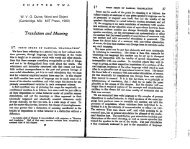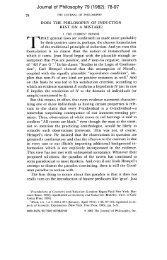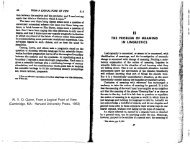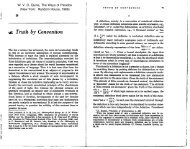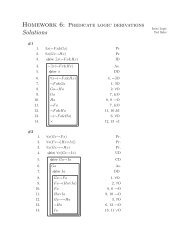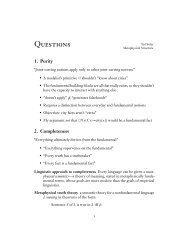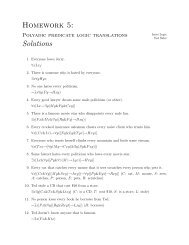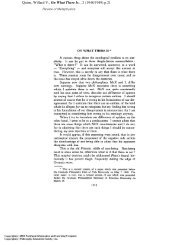Fine - guide to ground.pdf - Ted Sider
Fine - guide to ground.pdf - Ted Sider
Fine - guide to ground.pdf - Ted Sider
Create successful ePaper yourself
Turn your PDF publications into a flip-book with our unique Google optimized e-Paper software.
1<br />
Guide <strong>to</strong> Ground<br />
A number of philosophers have recently become receptive <strong>to</strong> the idea that, in addition <strong>to</strong><br />
scientific or causal explanation, there may be a distinctive kind of metaphysical explanation, in which<br />
explanans and explanandum are connected, not through some sort of causal mechanism, but through<br />
some form of constitutive determination. I myself have long been sympathetic <strong>to</strong> this idea of<br />
constitutive determination or ‘on<strong>to</strong>logical <strong>ground</strong>’; and it is the aim of the present paper <strong>to</strong> help put the<br />
idea on a firmer footing - <strong>to</strong> explain how it is <strong>to</strong> be unders<strong>to</strong>od, how it relates <strong>to</strong> other ideas, and how it<br />
1<br />
might be of use in philosophy.<br />
§1 The Notion of Ground<br />
There is an intuitive notion of one thing holding in virtue of another. Here are some examples:<br />
(1)The fact that the ball is red and round obtains in virtue of the fact that it is red and the fact<br />
that it is round;<br />
(2) The fact that the particle is accelerating obtains in virtue of the fact that it is being acted<br />
upon by some net positive force;<br />
(3) The fact that his action is wrong obtains in virtue of the fact that it was done with the sole<br />
intention of causing harm.<br />
There are some alternative - more or less equivalent - ways of saying the same thing. Thus instead of<br />
(2), we might say that the particle was accelerating because it was acted upon by a positive force or that<br />
1<br />
A number of other philosophers (Audi [2010], Batchelor [2009], Correia ([2005], [2010]), M. Raven [2009], Rosen<br />
[2010], Schnieder [2010]) have done related work in defense of the notion; and I have not attempted <strong>to</strong> make a<br />
detailed comparison between their ideas and my own. I am grateful <strong>to</strong> the participants at the Boulder conference on<br />
dependence for many helpful comments on a very early draft of the paper and also <strong>to</strong> Neil Tennant.
2<br />
the particle’s being acted upon by a positive force made it true that the particle was accelerating; and<br />
similarly for (1) and (3).<br />
In each of the above cases, there would appear <strong>to</strong> be some sort of modal connection between<br />
explandum and explanans. Thus from (1) - (3), it would appear <strong>to</strong> follow that:<br />
(1) Necessarily, if the ball is red and it is round then it is red and round;<br />
(2) Necessarily, if the particle is acted upon by some positive force then it is accelerating;<br />
(3) Necessarily, if the action was done with the intention of causing harm then it is wrong.<br />
However, it is arguable that the ‘force’ or ‘strength’ of the modal opera<strong>to</strong>r is different in each case. The<br />
first conditional (‘if the ball is red ...’) holds of metaphysical necessity, the second of natural necessity,<br />
2<br />
and the third of normative necessity.<br />
Whether or not this is so, there would appear <strong>to</strong> be something more than a modal connection in<br />
each case. For the modal connection can hold without the connection signified by ‘in virtue of’ or<br />
‘because’. It is necessary, for example, that if it is snowing then 2 + 2 = 4 (simply because it is<br />
necessary that 2 + 2 = 4), but the fact that 2 + 2 = 4 does not obtain in virtue of the fact that it is<br />
snowing; and it is necessary that if the ball is red and round then it is red but the fact that the ball is red<br />
does not obtain in virtue of its being red and round. In addition <strong>to</strong> the modal connection, there would<br />
also appear <strong>to</strong> be an explana<strong>to</strong>ry or determinative connection - a movement, so <strong>to</strong> speak, from<br />
antecedent <strong>to</strong> consequent; and what is most distinctive about the in-virtue-of claims is this element of<br />
movement or determination.<br />
We may call an in-virtue claim a statement of on<strong>to</strong>logical or metaphysical <strong>ground</strong> when the<br />
conditional holds of metaphysical necessity and I shall talk, in such cases, of the antecedent fact or facts<br />
<strong>ground</strong>ing or being a <strong>ground</strong> for the consequent fact. Thus we may say, in the first of the cases above,<br />
I have attempted <strong>to</strong> argue in <strong>Fine</strong> ([2005], chapter 7) that these are the basic forms of necessity, with no one of them<br />
2<br />
being reducible <strong>to</strong> the others.
3<br />
that the fact that the ball is red and round is <strong>ground</strong>ed in the fact that it is red and the fact that it is<br />
round. Just as metaphysical necessity is the strictest form of necessity (at least as compared <strong>to</strong> natural<br />
and normative necessity), so it is natural <strong>to</strong> suppose that statements of metaphysical <strong>ground</strong> are the<br />
strictest form of in-virtue-of claim. In the other cases, we may sensibly ask for a stricter or fuller<br />
account of that in virtue of which a given fact holds. So in the case of the particle, for example, we may<br />
agree that the particle is accelerating in virtue of being acted upon by a positive force but think that<br />
there is some kind of gap between the explanans and explanandum which could - at least in principle -<br />
be filled by a stricter account of that in virtue of which the explanandum holds. But if we were <strong>to</strong> claim<br />
that the particle is accelerating in virtue of increasing its velocity over time (which is presumably a<br />
statement of metaphysical <strong>ground</strong>), then we have the sense that there is - and could be - no stricter<br />
account of that in virtue of which the explanandum holds. We have as strict an account of the<br />
explanadum as we might hope <strong>to</strong> have.<br />
It is for this reason that it is natural in such cases <strong>to</strong> say that the explanans or explanantia are<br />
constitutive of the explanandum, or that the the explanandum’s holding consists in nothing more than<br />
the obtaining of the explanans or explanantia. But these phrases have <strong>to</strong> be properly unders<strong>to</strong>od. It is<br />
not implied that the explanandum just is the explanans (indeed, in the case that there are a number of<br />
explanantia, it is clear that this requirement cannot be met). Nor need it be implied that the<br />
explanandum is unreal and must somehow give way <strong>to</strong> the explanantia. In certain cases, one might<br />
wish <strong>to</strong> draw these further conclusions. But all that is properly implied by the statement of<br />
(metaphysical) <strong>ground</strong> itself is that there is no stricter or fuller account of that in virtue of which the<br />
explandandum holds. If there is a gap between the <strong>ground</strong>s and what is <strong>ground</strong>ed, then it is not an<br />
3<br />
explana<strong>to</strong>ry gap.<br />
3<br />
My remarks on this point in <strong>Fine</strong> ([2001], p. 16) have been over-interpreted by a number of authors.
6<br />
Questions of <strong>ground</strong> are not without interest <strong>to</strong> naive metaphysics, but they are central <strong>to</strong> realist<br />
metaphysics. Indeed, if considerations of <strong>ground</strong> were abolished, then very little of the subject would<br />
remain. For the anti-realist faces an explana<strong>to</strong>ry challenge. If he wishes <strong>to</strong> deny the reality of the<br />
mental, for example, then he must explain or explain away the appearance of the mental. It is likewise<br />
incumbent upon the realist, if he wishes <strong>to</strong> argue against his opponent, <strong>to</strong> show that this explana<strong>to</strong>ry<br />
challenge cannot be met.<br />
The question now is: how is this explana<strong>to</strong>ry challenge <strong>to</strong> be construed? What is it <strong>to</strong> explain<br />
the appearance of a world with minds in terms of a mindless world or the appearance of a world with<br />
value in terms of a purely naturalistic world? My own view is that what is required is that we somehow<br />
<strong>ground</strong> all of the facts which appear <strong>to</strong> presuppose the reality of the mental or of value in terms of facts<br />
4<br />
which do not presuppose their reality. Nothing less and nothing else will do.<br />
It will not do, for example, <strong>to</strong> say that the physical is causally determinative of the mental, since<br />
that leaves open the possibility that the mental has a distinct reality over and above that of the physical.<br />
Nor will it do <strong>to</strong> require that there should be an analytic definition of the mental in terms of the<br />
physical, since that imposes far <strong>to</strong>o great a burden on the anti-realist. Nor is it enough <strong>to</strong> require that<br />
the mental should modally supervene on the physical, since that still leaves open the possibility that the<br />
physical is itself ultimately <strong>to</strong> be unders<strong>to</strong>od in terms of the mental.<br />
The his<strong>to</strong>ry of analytic philosophy is littered with attempts <strong>to</strong> explain the special way in which<br />
one might attempt <strong>to</strong> ‘reduce’ the reality of one thing <strong>to</strong> another. But I believe that it is only by<br />
embracing the concept of a <strong>ground</strong> as a metaphysical form of explanation in its own right that one can<br />
adequately explain how such a reduction should be unders<strong>to</strong>od. For we need a connection as strong as<br />
that of metaphysical necessity <strong>to</strong> exclude the possibility of a ‘gap’ between the one thing and the other;<br />
The above account of <strong>ground</strong> and of its role in realist metaphysics is further discussed in <strong>Fine</strong> [2001]. I do not<br />
4<br />
presuppose that the one set of facts must <strong>ground</strong>-theoretically supervene on the other set of facts.
7<br />
and we need <strong>to</strong> impose a form of determination upon the modal connection if we are <strong>to</strong> have any<br />
general assurance that the reduction should go in one direction rather than another.<br />
The explana<strong>to</strong>ry challenge constitutes the core of realist metaphysics. An anti-realist position<br />
stands or falls according as <strong>to</strong> whether or not it can be met. And so given that the challenge is <strong>to</strong> be<br />
construed in terms of <strong>ground</strong>, the subject of realist metaphysics will be largely constituted by<br />
considerations of <strong>ground</strong>. We must attempt <strong>to</strong> determine what <strong>ground</strong>s what; and it will be largely on<br />
this basis that we will be in a position <strong>to</strong> determine the viability of a realist or anti-realist stand on any<br />
given issue.<br />
In addition <strong>to</strong> this grand role, the notion of <strong>ground</strong> has a humbler role <strong>to</strong> play in clarifying the<br />
concepts and claims of interest <strong>to</strong> other branches of philosophy. Let me give one of my favorite<br />
examples. How are we <strong>to</strong> distinguish between a three- and four-dimensionalist view of the nature of<br />
material things? The distinction is often put in terms of the existence of temporal parts, with the three-<br />
dimensionalist denying that material things have temporal parts (or a suitable range of temporal parts)<br />
and the four-dimensionalist insisting that they have such parts. But even the three-dimensionalist might<br />
be willing <strong>to</strong> admit that material things have temporal parts. For given any persisting object, he might<br />
suppose that ‘in thought’, so <strong>to</strong> speak, we could mark out its temporal segments or parts. But his<br />
difference from the four-dimensionalist will then be over a question of <strong>ground</strong>. For he will take the<br />
existence of a temporal part at a given time <strong>to</strong> be <strong>ground</strong>ed in the existence of the persisting object at<br />
that time, while his opponent will take the existence of the persisting object at the time <strong>to</strong> be <strong>ground</strong>ed<br />
in the existence of the temporal part. Thus it is only by introducing the notion of <strong>ground</strong> that this<br />
5<br />
account of the difference between the two positions can be made at all plausible.<br />
Cf. Hawthorne ([2006], p. 100). Rosen ([2010], fn. 1) has another example concerning the analysis of intrinsic<br />
5<br />
property and Correia ([2005], chapters 4) provides various accounts of dependence in terms of <strong>ground</strong>.
8<br />
§3 Ground and Truth-Making<br />
The notion of <strong>ground</strong> is a close cousin of the notion of truth-making. Both are bound up with<br />
the general phenomenon of what accounts for what, but there are some significant differences in how<br />
6<br />
they structure the phenomenon.<br />
The relation of truth-making relates an entity in the world, such as a fact or state of affairs, <strong>to</strong><br />
something, such as a statement or proposition, that represents how the world is; and the intended<br />
understanding of the relation is that the existence of the worldly entity should guarantee the truth of the<br />
representing entity. Ground, on the other hand, is perhaps best regarded as an operation (signified by an<br />
opera<strong>to</strong>r on sentences) rather than as a relation (signified by a predicate). But in so far as it is regarded<br />
as a relation, it should be seen <strong>to</strong> hold between entities of the same type and, in so far as a choice needs<br />
<strong>to</strong> be made, these entities should probably be taken <strong>to</strong> be worldly entities, such as facts, rather than<br />
representational entities, such as propositions. Thus it is that the ball is red and that the ball is round that<br />
makes it the case that the ball is red and round, and not the existence of the facts that the ball is red and<br />
that the ball is round that make the proposition that it is red and round true.<br />
From the perspective of the theory of <strong>ground</strong>, truth-maker theory has an unduly restricted<br />
conception of what is <strong>ground</strong>ed. One might of course be interested in the <strong>ground</strong> for the truth or<br />
correctness of our representations of the world (in which case, it is presumably not merely the truth of<br />
one class of representations that will be of interest, but the class of all representations - be they<br />
linguistic, mental or abstract). But these are by no means the only questions of <strong>ground</strong> or ‘making’ that<br />
will arise. For whenever we consider the question of what makes the representation that P true, there<br />
will also arise the question of what, if anything, makes it the case that P. Indeed, it might well be<br />
Truth-making has been widely discussed (see, for example, Mulligan et al [1984], Fox [1987] and Armstrong<br />
6<br />
([1997], [2004])) and a number of authors (most notably Schnieder [2006] and Horwich [2008]) have made some<br />
related criticisms concerning the connection between truth-making and <strong>ground</strong>. Cameron [2011] is a recent survey<br />
in which the notion of <strong>ground</strong> is explicitly imported in<strong>to</strong> the formulation of truth-making.
9<br />
thought that the question concerning the representation will always divide in<strong>to</strong> two parts, one<br />
concerning the <strong>ground</strong> for what it is for the representation that P <strong>to</strong> represent P and the other having<br />
nothing <strong>to</strong> do with representations as such, but concerning the <strong>ground</strong> for P.<br />
From the perspective of the theory of <strong>ground</strong>, truth-maker theory is also unduly restrictive in its<br />
conception of what <strong>ground</strong>s. For it insists that <strong>ground</strong>s should take the form of existential attributions;<br />
it is always the existence of something that properly accounts for the truth of the representation. But<br />
there is no reason in principle why the ultimate source of what is true should always lie in what exists.<br />
Perhaps it can lie in something relational, a standing in the relation R <strong>to</strong> b, or the negation of something<br />
relational, a not standing in the relation R <strong>to</strong> b, or in something of some other form.<br />
Indeed, the existential view of <strong>ground</strong> is somewhat suspect in itself. For it is much more natural<br />
<strong>to</strong> suppose that it is because P (e.g. it is raining) that the fact that P exists, rather than the other way<br />
round. One can only conjecture as <strong>to</strong> why truth-maker theorists might have built such an implausible<br />
view in<strong>to</strong> their conception of truth-making. One possible reason is that they wanted something that<br />
would clearly indicate that the <strong>ground</strong>s were in the world and, just as truth indicates that what is<br />
<strong>ground</strong>ed lies on the side of representation, so existence indicates that what <strong>ground</strong>s lies on the side of<br />
the world. Be that as it may, it is clearly preferable if our conception of what accounts for what should<br />
remain neutral over the form of the relata.<br />
The lack of uniformity between what <strong>ground</strong>s and what is <strong>ground</strong>ed gives rise <strong>to</strong> another<br />
limitation in truth-maker theory. For in attempting <strong>to</strong> determine what <strong>ground</strong>s what, one naturally<br />
proceeds in stages - first determining the relatively immediate <strong>ground</strong>s for the truths in question, then<br />
the relatively immediate <strong>ground</strong>s of those <strong>ground</strong>s, and so on until one reaches the ultimate <strong>ground</strong>s.<br />
So, for example, one might first <strong>ground</strong> the normative in the natural, then the natural in the physical,<br />
and then the physical in the micro-physical, thereby establishing that the normative was <strong>ground</strong>ed in the<br />
micro-physical.
11<br />
will the fact that Socrates exists be a truth-maker for the proposition that single<strong>to</strong>n Socrates exists, the<br />
fact that single<strong>to</strong>n Socrates exists will be a truth-maker for the proposition that Socrates exists. Thus<br />
whereas the form of the relata makes truth-making <strong>to</strong>o restrictive, the nature of the relation makes it <strong>to</strong>o<br />
liberal.<br />
It is conceivable that the restrictions on the relata were a way for compensating for the<br />
deficiencies in the relation. For if P were taken <strong>to</strong> be a truth-maker for Q whenever P necessitated Q,<br />
then every truth would trivially be a truth-maker for itself. By insisting that the <strong>ground</strong>s should take the<br />
form of something that exists and that what is <strong>ground</strong>ed should take the form of something that is true,<br />
we avoid trivializations of this sort; and we can even ensure that the relation be irreflexive and anti-<br />
symmetric, since the objects <strong>to</strong> the right and left of the relation will be of different type.<br />
But we have here a mere chimera of substantiality. Indeed, on certain quite plausible<br />
metaphysical views, there will still exist wholesale trivializations of the truth-making project. One<br />
might well think, for example, that for any truth p, the fact that p will exist and will require the truth of<br />
p for its existence. The fact that p will then be a truth-maker for any true proposition p. Or one might<br />
think that the world exists and could not exist without being the way it is. The world would then be a<br />
truth-maker for any true proposition. But such innocuous metaphysical views cannot legitimately be<br />
regarded as enabling us <strong>to</strong> find a truth-maker for every truth.<br />
The notion of truth-making is thoroughly ill-suited <strong>to</strong> the task for which it was intended: it<br />
arbitrarily restricts the relata between which the relation should be capable of holding; it does not allow<br />
truth-making connections <strong>to</strong> be chained; and it trivializes the project of finding truth-makers. Perhaps<br />
the best that can be said in its favor is that it provides a necessary condition for the intended relation: if<br />
P genuinely <strong>ground</strong>s Q then the fact that P will be a truth-maker for the proposition that Q. It is<br />
therefore possible that, by looking for truth-makers and <strong>guide</strong>d by a sense of what is really in question,
14<br />
but shall simply assume that there is some way of understanding sentential and sequential quantification<br />
that is compatible with treating the opera<strong>to</strong>r as basic. If this is not so, then the opera<strong>to</strong>r approach may<br />
need <strong>to</strong> be given up in favor of one of the alternatives.<br />
The <strong>ground</strong>ing opera<strong>to</strong>r ‘
20<br />
at best, mediately <strong>ground</strong>ed in statements about a<strong>to</strong>ms. It is the notion of immediate <strong>ground</strong> that<br />
provides us with our sense of a <strong>ground</strong>-theoretic hierarchy. For given any truth, we can take its<br />
immediate <strong>ground</strong>s <strong>to</strong> be at the next lower level. Thus as long as mediate <strong>ground</strong>s are always mediated<br />
through immediate <strong>ground</strong>s, any partial <strong>ground</strong> for the truth will always be at some finite level below<br />
the level of the truth.<br />
Weak/Strict Ground<br />
The fourth distinction, between weak and strict <strong>ground</strong>, is less familiar still. Ground in the<br />
previous sense is strict and does not allow a truth <strong>to</strong> <strong>ground</strong> itself, while <strong>ground</strong> in the weak sense<br />
allows - and, indeed, requires - that a truth should <strong>ground</strong> itself.<br />
We might perhaps express weak <strong>ground</strong> by means of the locution ‘for - and for - and ... is for -’,<br />
where the last ‘for’ specifies the statement <strong>to</strong> be <strong>ground</strong>ed and the first ‘for’’s specify its <strong>ground</strong>s. Thus<br />
for John <strong>to</strong> marry Mary is for John <strong>to</strong> marry Mary, for John <strong>to</strong> marry Mary is for Mary <strong>to</strong> marry John,<br />
and for John <strong>to</strong> marry Mary and for Mary <strong>to</strong> marry John is for John <strong>to</strong> marry Mary. Or <strong>to</strong> take a<br />
somewhat different example, for Hesperus <strong>to</strong> be identical <strong>to</strong> Phosphorus and for Phosphorus <strong>to</strong> be a<br />
planet is for Hesperus <strong>to</strong> be a planet (in this case, it might be argued that, in contrast <strong>to</strong> the others, the<br />
<strong>ground</strong>ed truth does not weakly <strong>ground</strong> any of its <strong>ground</strong>s).<br />
What is characteristic of these cases is that any explana<strong>to</strong>ry role that can be played by the given<br />
truth can also be played by their <strong>ground</strong>s. Thus if John’s marrying Mary accounts for the existence of<br />
the married couple John and Mary, then Mary’s marrying John also accounts for the existence of the<br />
married couple. Or if John’s marrying Mary accounts for John’s marrying Mary or Bill’s marrying Sue<br />
then Mary’s marrying John will also account for John’s marrying Mary or Bill’s marrying Sue.<br />
We might think of strict <strong>ground</strong> as moving us down in the explana<strong>to</strong>ry hierarchy. It always<br />
takes us <strong>to</strong> a lower level of explanation and, for this reason, a truth can never be strict <strong>ground</strong> for itself.
46<br />
predication. Thus if the subject is Charles and the property is the property of being an unmarried man<br />
(Ëx(x is unmarried & x is a man)), then the resulting proposition is the one expressed by the sentence<br />
‘Charles is an unmarried man’ (‘ëx(x is a man & x is unmarried)(Charles)’). Thus the property<br />
occurs as a property (or predicatively) in the resulting proposition.<br />
The predication can also be upward. Thus if the subject is Charles and the property is the<br />
property of being an unmarried man (Ëx(x is unmarried & x is a man)), then the resulting proposition<br />
is the one expressed by the sentence ‘Charles has the property of being an unmarried man’ (‘Ëx(x is<br />
a man & x is unmarried)[Charles]’). Here the property occurs as an object (or nominally) in the<br />
resulting proposition. As I have mentioned, a plausible view is that the upward predication of P of x<br />
is the same as the straight predication of the relation of having of P and x; and if this is so, then<br />
upward predication is directly reducible <strong>to</strong> straight predication.<br />
Finally, the predication can be downward. If the subject is Charles and the property is the<br />
property of being an unmarried man (Ëx(x is unmarried & x is a man)), then the resulting proposition<br />
is the one expressed by the sentence ‘Charles is a man & Charles is unmarried’. Here the property<br />
occurs an abstract (or as the result of abstraction) in the resulting proposition. It is seen <strong>to</strong> be present<br />
in the proposition through a process of abstraction whereby the subject (Charles) is removed and the<br />
property remains. We cannot give a direct definition of downward predication in terms of straight<br />
predication but the result of downward predication can always be seen <strong>to</strong> be the result of straight<br />
predication. The proposition that Charles is unmarried & Charles is a man, for example, can also be<br />
seen <strong>to</strong> be the result of conjoining the straight predication of the property of being unmarried of<br />
Charles with the straight predication of the property of being a man of Charles.<br />
So even though the propositions expressed by ‘Ëx(x is unmarried & x is a man)[Charles]’,<br />
‘ëx(x is unmarried & x is a man)(Charles)’ and ‘Charles is unmarried & Charles is a man’ are each<br />
the result of predicating the property of being an unmarried man of the subject Charles, they are each
47<br />
this result by means of a different manner of predication; and there is therefore no difficulty in<br />
distinguishing between the propositions or in allowing the <strong>ground</strong>ing relations between them may <strong>to</strong><br />
20 obtain.<br />
§10 The Semantics of Ground<br />
There is a standard ‘possible worlds’ semantics for logical consequence or entailment. Under<br />
this semantics, each sentence A of the language under consideration is associated with the ‘truth-set’<br />
|A| of possible worlds in which it is true, and it is then supposed that:<br />
C is a consequence of A 1, A 2,<br />
… iff a world w verifies C (i.e. is a member of the truth-set |A|)<br />
whenever it verifies each of A 1, A 2, … (i.e. whenever it belongs <strong>to</strong> each of the truth-sets |A 1|, |A 2|,<br />
…).<br />
This semantics is not suited <strong>to</strong> the notion of <strong>ground</strong> since it conforms <strong>to</strong> Weakening. If C is a<br />
consequence of A 1, A 2, … then it is a consequence of A 1, A 2, … along with any other sentences B 1,<br />
B 2,<br />
…. But is there any alternative account of the semantics of sentences and of the connection of<br />
<strong>ground</strong> that might be made <strong>to</strong> work?<br />
It turns out that one can provide a very natural semantics of this sort in terms of the idea of<br />
truth-making. I have had some harsh things <strong>to</strong> say about truth-maker theory. But even though it<br />
might not amount <strong>to</strong> much as an approach <strong>to</strong> on<strong>to</strong>logy, it provides an ideal framework within which<br />
Rosen [2010], p. 125, is of the view that the proposition that a is grue (where <strong>to</strong> be grue is <strong>to</strong> be<br />
20<br />
red or green) and the proposition that a red or green will differ in that (i) the former but not the<br />
latter will contain grue and (ii) the latter but not the former will contain green. Thus where I see<br />
a difference in the manner of composition (or predication), he sees a difference in the<br />
constituents. The first of his two claims is much more plausible than the second, but only the<br />
first is required <strong>to</strong> distinguish between the two propositions. I could perhaps agree with him on<br />
the first claim (even if not on the second) under a construal of composition in which composition<br />
through abstraction is not allowed. However, I believe that the downward form of composition<br />
should not simply be ignored but should be recognized as a genuine form of composition in its<br />
own right. For more on the underlying conception of composition, see <strong>Fine</strong> [2011b].
53<br />
§11 Essence and Ground<br />
Given an object or some objects, we may say that it lies in the nature of those objects that<br />
such and such should hold – that it lies, in the nature of single<strong>to</strong>n Socrates, for example, that it should<br />
have Socrates as a member. But what then is the connection between statements of nature or essence<br />
and statements of <strong>ground</strong>? 22<br />
A natural view is this. Given that the fact F is <strong>ground</strong>ed in the facts G 1, G 2,<br />
…, then it lies in<br />
the nature of the fact F (or of the items that it involves) that it should be so <strong>ground</strong>ed given that the<br />
facts G 1, G 2,<br />
… do indeed obtain. So, for example, given that the fact that the ball is red and round is<br />
<strong>ground</strong>ed in the fact that it is red and the fact that it is round, it will lie in the nature of the fact that<br />
the ball is red and round that this fact will be <strong>ground</strong>ed in the fact that the ball is red and the fact that<br />
23<br />
the ball is round (given that the ball is in fact red and is in fact round).<br />
Unfortunately, this view will not quite do as it stands. The fact that someone is a philosopher,<br />
we may suppose, is <strong>ground</strong>ed in the fact that Socrates is a philosopher (and perhaps also that he<br />
exists and is a person). But it does not lie in the nature of the fact that someone is a philosopher that<br />
the fact is so <strong>ground</strong>ed given that Socrates is indeed a philosopher. The fact, so <strong>to</strong> speak, knows<br />
nothing of Socrates. Or again, the fact that the ball is colored is <strong>ground</strong>ed, we may suppose, in the<br />
fact that it is red. But it does not lie in the nature of the fact that the ball is colored that it is so<br />
<strong>ground</strong>ed given that the ball is indeed red. The fact and color, in particular, know nothing of the<br />
specific colors.<br />
22<br />
The concept of essence is further discussed in <strong>Fine</strong> [1994].<br />
23<br />
I say that it lies in the nature of the fact that the ball is red and round and thereby treat the fact as an object<br />
(perhaps identical <strong>to</strong> the proposition that the ball is red and round). But there is something <strong>to</strong> be said for allowing it<br />
<strong>to</strong> lie in the nature of what it is for the ball <strong>to</strong> be red and round, where this is represented by a sentential rather than<br />
by a nominal complement <strong>to</strong> the essentialist opera<strong>to</strong>r.
54<br />
The difficulty in these cases arises from the <strong>ground</strong>s G 1, G 2,<br />
… being merely an instance of<br />
the <strong>ground</strong>s that the given fact F is capable of possessing. Thus the fact that someone is a<br />
philosopher could equally well be <strong>ground</strong>ed in the fact that Pla<strong>to</strong> is a philosopher and the fact that the<br />
ball is colored could equally well be <strong>ground</strong>ed in the fact that it is blue. But suppose that we<br />
generalize the statement of <strong>ground</strong>. We say that the fact that someone is a philosopher is, for any<br />
person x, <strong>ground</strong>ed in the fact that x is a philosopher given that x is indeed a philosopher and that the<br />
fact that the ball is colored is, for any color c, <strong>ground</strong>ed in the fact that the ball is of color c given that<br />
the ball is indeed of color c. It does then seem plausible <strong>to</strong> say that these generalized statements of<br />
<strong>ground</strong> will hold in virtue of the nature of the <strong>ground</strong>ed fact – that it lies in the nature of the fact that<br />
someone is a philosopher, for example, that this fact will, for any person x, be <strong>ground</strong>ed in the fact<br />
that x is a philosopher given that x is indeed a philosopher.<br />
Let us state the point more generally. Suppose that the truth C is <strong>ground</strong>ed in B 1, B 2,<br />
….<br />
Then the <strong>ground</strong>s B 1, B 2, … will concern certain existing items a 1, a 2,<br />
…and so may be stated in the<br />
form B 1(a 1, a 2, …), B 2(a 1, a 2,<br />
…), …. A generalization of this particular connection of <strong>ground</strong> will<br />
therefore take the form:<br />
B 1(x 1, x 2, …), B 2(x 1, x 2, …), … is a <strong>ground</strong> for C whenever A(x 1, x 2,<br />
…),<br />
24<br />
where A(x 1, x 2, …) is a condition that in fact holds of a 1, a 2, …. Thus given that A(x 1, x 2,<br />
…) in fact<br />
holds of the existing items a 1, a 2,<br />
…, the particular connection of <strong>ground</strong> will logically follow from<br />
the general connection.<br />
What we may now claim is that whenever a given truth C is <strong>ground</strong>ed in other truths, then<br />
there is a generalization of the particular connection of <strong>ground</strong> that will hold in virtue of the nature of<br />
24<br />
Strictly speaking, we should also require that it is a necessary truth that B 1(x 1, x 2, …), B 2(x<br />
1, x 2,<br />
…), … is a<br />
<strong>ground</strong> for C whenever A(x , x , …) and B (x , x , …), B (x , x , …), … are the case.<br />
1 2 1 1 2 2 1 2
55<br />
C (or of the items it involves). Thus the particular explana<strong>to</strong>ry connection between the fact C and its<br />
<strong>ground</strong>s may itself be explained in terms of the nature of C.<br />
It should be noted that what explains the <strong>ground</strong>-theoretic connection is something<br />
concerning the nature of the fact that C (or of what it is for C <strong>to</strong> be the case) and not of the <strong>ground</strong>ing<br />
facts themselves. Thus what explains the ball’s being red or green in virtue of its being red is<br />
something about the nature of what it is for the ball <strong>to</strong> be red or green (and about the nature of<br />
disjunction in particular) and not something about the nature of what it is for the ball <strong>to</strong> be red. It is<br />
the fact <strong>to</strong> be <strong>ground</strong>ed that ‘points’ <strong>to</strong> its <strong>ground</strong>s and not the <strong>ground</strong>s that point <strong>to</strong> what they may<br />
<strong>ground</strong>.<br />
One might hold that the <strong>ground</strong>-theoretic connection holds in virtue of the nature of its<br />
<strong>ground</strong>s and the general nature of <strong>ground</strong> in addition <strong>to</strong> the nature of the fact <strong>to</strong> be <strong>ground</strong>ed. But<br />
this is a far weaker and far less interesting claim. For it might be held as a general thesis that every<br />
necessary truth is <strong>ground</strong>ed in the nature of certain items (<strong>Fine</strong> [1994]); and, as a rule, these will be<br />
the items involved in the necessary truth itself. But given that C is <strong>ground</strong>ed in B 1, B 2,<br />
…, it will be<br />
necessary that C is <strong>ground</strong>ed in B 1, B 2, … if B 1, B 2,<br />
… are the case; and so it will follow from the<br />
general thesis that it lies in the nature of certain items – presumably those involved in C and B 1, B 2,<br />
… and <strong>ground</strong> itself - that this is so. Claiming that the fact <strong>to</strong> be <strong>ground</strong>ed bears full responsibility,<br />
so <strong>to</strong> speak, for the <strong>ground</strong>-theoretic connection is <strong>to</strong> make an essentialist claim that goes far beyond<br />
the assertion of a general link between necessity and nature.<br />
Part of the interest of the stronger thesis lies in its bearing upon the methodology of<br />
metaphysics. For investigation in<strong>to</strong> <strong>ground</strong> is part of the investigation in<strong>to</strong> nature; and if the<br />
essentialist locus of <strong>ground</strong>-theoretic connections lies in the fact <strong>to</strong> be <strong>ground</strong>ed and not in the<br />
<strong>ground</strong>s, then it is by investigating the nature of the items involved in the facts <strong>to</strong> be <strong>ground</strong>ed rather<br />
than in the <strong>ground</strong>s that we will discover what <strong>ground</strong>s what. Thus the asymmetry supports a <strong>to</strong>p-
56<br />
down approach in which we start with the facts <strong>to</strong> be <strong>ground</strong>ed and work our way down <strong>to</strong> their<br />
<strong>ground</strong>s, rather than the other way round.<br />
Part of the interest of the stronger thesis also lies in its bearing upon the general nature of<br />
objects. If we were merely given a general link between necessity and nature, then this would be<br />
perfectly compatible with <strong>ground</strong>-theoretic connections always holding partly in virtue of the nature<br />
of <strong>ground</strong>. Thus the nature of being colored might have nothing <strong>to</strong> do with <strong>ground</strong>; and so whereas it<br />
might lie in the nature of being colored that anything colored was of a particular color, it would not<br />
lie in the nature of being colored that anything colored was colored in virtue of being a particular<br />
color. What then accounted for the fact that anything colored was colored in virtue of being a<br />
particular color would be something about the nature of being colored and something about the<br />
nature of <strong>ground</strong>. The nature of <strong>ground</strong> would somehow ‘feed off’ the nature of being colored <strong>to</strong><br />
give us this particular <strong>ground</strong>-theoretic connection.<br />
But what is being claimed is that this is not so and that <strong>ground</strong>-theoretic connections will be<br />
inextricably involved in the nature of certain things. It is not just that they must, by their very nature,<br />
behave in a certain way but that there must, by their very nature, be a certain <strong>ground</strong>-theoretic basis<br />
for their behavior. Thus it may well be thought <strong>to</strong> be essential <strong>to</strong> the nature of being colored not<br />
merely that anything colored is of a specific color but that anything colored is colored in virtue of<br />
being a specific color; the <strong>ground</strong>-theoretic basis for being colored is built in<strong>to</strong> the very identity of<br />
what it is <strong>to</strong> be colored.<br />
Rosen ([2010], 132-3) has suggested some counter-examples <strong>to</strong> the proposed link between<br />
<strong>ground</strong> and essence (and even <strong>to</strong> weaker versions of the link). Suppose, for example, that<br />
something’s being right or good is <strong>ground</strong>ed in certain naturalistic features of the object. Then on a<br />
nonreductive view of normativity, it will not lie in the nature of right or good that it is <strong>ground</strong>ed in<br />
these particular features. And similarly for the case of a nonreductive materialist, who thinks that
57<br />
facts about pain are <strong>ground</strong>ed in facts about our brain or the like and yet does not think that it lies in<br />
the nature of pain that it should be so <strong>ground</strong>ed.<br />
My own view is that the apparent plausibility of these counter-examples depends upon<br />
conflating different conceptions of <strong>ground</strong>. Corresponding <strong>to</strong> the concepts of normative and natural<br />
necessity will be normative and natural conceptions of <strong>ground</strong>, which are <strong>to</strong> be distinguished from<br />
the purely metaphysical conception. The view that the normative is <strong>ground</strong>ed in the natural is only<br />
plausible for the normative conception of <strong>ground</strong> and the view that the mental is <strong>ground</strong>ed in the<br />
physical is only plausible for the natural conception. Since the <strong>ground</strong>ing relation in these cases is<br />
not metaphysical, there is no need for there <strong>to</strong> be explanation of its holding in terms of the essentialist<br />
nature of the items involved. What may be plausible, though, is that it should lie in the nature of<br />
goodness, say, that it should have some <strong>ground</strong> in what is natural and that it should lie in the nature of<br />
pain that it should have some <strong>ground</strong> in what is physical; and if the respective conceptions of <strong>ground</strong><br />
here are normative and natural, then we see that these other conceptions of <strong>ground</strong> may have an<br />
important role <strong>to</strong> play in delineating the nature of certain essentially ‘realized’ properties or<br />
25 features.<br />
Given the proposed connection between essence and <strong>ground</strong>, it might be wondered whether it<br />
26<br />
might somehow be converted in<strong>to</strong> a definition of <strong>ground</strong>. For given that B 1, B 2,<br />
… is a <strong>ground</strong> for<br />
25<br />
I have benefitted from Rosen’s ([2010], §13) discussion of these issues and our views are somewhat alike. But<br />
note that whereas I have one thesis, that any <strong>ground</strong>-theoretic connection can be generalized <strong>to</strong> one that flows from<br />
the nature of the items involved in the given fact, he has two theses: that any <strong>ground</strong>-theoretic connection can be<br />
generalized; and that any general <strong>ground</strong>-theoretic connection will flow from the nature of the items involved in the<br />
given fact and its <strong>ground</strong>s. Thus my view traces the source of the <strong>ground</strong>-theoretic connection <strong>to</strong> the nature of the<br />
items involved in the given fact while his also appeals <strong>to</strong> the nature of the items involved in its <strong>ground</strong>s. I should<br />
add that there are problems with his formulation of Formality (p. 131). Merely saying that a statement of <strong>ground</strong> has<br />
a generalization is not enough. The ball is perhaps red or round because it is red. But the required level of<br />
generality is not achieved by saying that anything will be red or round because it is red. Moreover, the appropriate<br />
generalization cannot in general be stated simply through appeal <strong>to</strong> propositional forms. One might think, for<br />
example, that the species Dog exists because there are dogs. But how are we <strong>to</strong> generalize this without appealing <strong>to</strong><br />
the connection between Dog and being a dog? Our own formulation avoids these problems.<br />
E. J. Lowe considers and points out some difficulties in providing an essentialist account of truth-making in chapter<br />
26<br />
11 of Lowe and Rami [2008].
59<br />
more inclined, is that we understand the former in terms of the latter. One statement of<br />
consequentialist essence may be partly <strong>ground</strong>ed in others. The fact that it lies in the nature of a<br />
given set <strong>to</strong> be a set or a set, for example, is partly <strong>ground</strong>ed in the fact that it lies in the nature of the<br />
set <strong>to</strong> be a set. The constitutive claims of essence can then be taken <strong>to</strong> be those consequentialist<br />
statements of essence that are not partly <strong>ground</strong>ed in other such claims. This way of conceiving the<br />
distinction enables us <strong>to</strong> ‘fac<strong>to</strong>r out’ the purely essentialist aspect of the concept of essence from the<br />
partly explana<strong>to</strong>ry aspect. But it means that the constitutive concept of essence is then of no help <strong>to</strong><br />
us in understanding the concept of <strong>ground</strong>.<br />
But there is perhaps a more serious objection <strong>to</strong> the proposed definition, which may arise<br />
even when we make use of the constitutive conception of essence. For certain statements of essence<br />
appear <strong>to</strong> be symmetric between <strong>ground</strong> and what is <strong>ground</strong>ed. It might be thought, for example, that<br />
there is a distinction between existing at a time and existing simpliciter and that it is essential <strong>to</strong> any<br />
object that exists in time that it exists simpliciter iff it exists at a time. But the definition will then<br />
give us an equal right <strong>to</strong> say that the object exists simpliciter in virtue of existing at a time and that it<br />
exists at a time in virtue of existing simpliciter. But compatibly with the essentialist claim, we might<br />
want <strong>to</strong> make the first of these <strong>ground</strong>-theoretic statements <strong>to</strong> the exclusion of the other and we<br />
would certainly not want <strong>to</strong> make both statements under a strict conception of <strong>ground</strong> or even under a<br />
weak conception of <strong>ground</strong>, given that existing at a time essentially involves the notion of time while<br />
existing simpliciter does not.<br />
I think it should be recognized that there are two fundamentally different types of<br />
explanation. One is of identity, or of what something is; and the other is of truth, or of how things<br />
are. It is natural <strong>to</strong> want <strong>to</strong> reduce them <strong>to</strong> a common denomina<strong>to</strong>r - <strong>to</strong> see explanations of identity as<br />
a special kind of explanation of the truth or <strong>to</strong> see explanations of truth as a special kind of
60<br />
explanation of identity or <strong>to</strong> see them in some other way as instances of a single form of explanation.<br />
But this strikes me as a mistake.<br />
Carnap distinguished some time ago between formation and transformation rules. The former<br />
were for the construction of formulas and the latter for the construction of proofs. The formation<br />
rules provide an explanation of identity, of what the formulas are, while the transformation rules help<br />
provide an explanation of truth, of when a formula is true (or valid). It would clearly be an error <strong>to</strong><br />
think of the one kind of rule as an instance of the other or <strong>to</strong> see them as falling under a common<br />
rubric. And it seems <strong>to</strong> me that there is a similar error - but writ large over the whole metaphysical<br />
landscape - in attempting <strong>to</strong> assimilate or unify the concepts of essence and <strong>ground</strong>. The two<br />
concepts work <strong>to</strong>gether in holding up the edifice of metaphysics; and it is only by keeping them<br />
separate that we can properly appreciate what each is on its own and what they are capable of doing<br />
<strong>to</strong>gether.<br />
References<br />
Armstrong J., [1997] ‘A World of States of Affairs’, Cambridge: Cambridge University Press.<br />
Armstrong J., [2004] ‘Truth and Truthmakers’, Cambridge: Cambridge University Press.<br />
Audi Paul [2010?] ‘Grounding’, <strong>to</strong> appear.<br />
Batchelor R. [2009] ‘Grounds and Consequences’, <strong>to</strong> appear in Grazer Philosophische Studien.<br />
Blackburn S., [1987] ‘Morals and Modals’, in ‘Fact, Science and Value: Essays in Honor of A. J.<br />
Ayer’s ‘Language, Truth and Logic’’ (eds. C. Wright and G. MacDonald), Oxford:<br />
Blackwell, reprinted in ‘Essays in Quasi-Realism’, Oxford: Oxford University Press.<br />
Cameron R., [2011] ‘Truth-makers’, <strong>to</strong> appear in ‘Oxford Handbook of Truth’ (ed. M. Glanzberg),<br />
Oxford: Oxford University Press.
61<br />
Correia F., [2005] ‘Existential Dependence and Cognate Notions’, Philosophica Verlag.<br />
<strong>Fine</strong> K., [1975] Review of ‘Counterfactuals’ by David Lewis, Mind 84, 451-8; reprinted in<br />
‘Modality and Tense: Philosophical Papers’, Oxford: Clarendon Press (2005).<br />
<strong>Fine</strong> K., [1994] ‘Essence and Modality’, Philosophical Perspectives 8, 1-16.<br />
<strong>Fine</strong> K., [2001] ‘The Question of Realism’, Imprint, vol. 1, no. 1, 2001; reprinted in ‘Individuals,<br />
Essence and Identity: Themes of Analytic Philosophy’ (ed. A. Bottani, M Carrara, P.<br />
Giaretta), Dordrecht: Kluwer 2002, 3- 41.<br />
<strong>Fine</strong> K., [2003] ‘Senses of Essence’, in ‘Modality, Morality and Belief: Essays in Honor of Ruth<br />
Barcan Marcus’ (ed. W. Sinnott-Armstrong), Cambridge: Cambridge University Press.<br />
<strong>Fine</strong> K., [2005] ‘The Varieties of Necessity’, in ‘Modality and Tense: Philosophical Papers’, Oxford:<br />
Oxford University Press.<br />
<strong>Fine</strong> [2010] ‘Some Puzzles Concerning Ground’, Notre Dame Journal of Formal Logic 51(1), 97-<br />
118.<br />
<strong>Fine</strong> [2011a] ‘The Pure Logic of Ground’, <strong>to</strong> appear.<br />
<strong>Fine</strong> [2011b] ‘Toward a Theory of Part’, <strong>to</strong> appear in the Journal of Philosophy.<br />
Fox J. F. [1987] ‘Truthmaker’, Australasian Journal of Philosophy 65, 188-207.<br />
Hawthorne J., [2006] ‘Metaphysical Essays’, Oxford: Oxford University Press.<br />
Horwich P., [2008] ‘Being and Truth’, Midwest Studies in Philosophy 32, 258-73.<br />
Lowe E. J., and Rami A., (eds) [2008] ‘Truth and Truth-making’, UK.: Acumen Publishing.<br />
Mulligan K., Simons P., Smith B., [1984] ‘Truth-Makers’, Philosophy and Phenomenological<br />
Research 44, 210-55.<br />
Raven M., [2009] ‘On<strong>to</strong>logy, From a Fundamentalist Point of View’, Ph. D., New York University.<br />
Rosen G., [2010] ‘Metaphysical Dependence: Grounding and Reduction’, <strong>to</strong> appear in a collection of<br />
papers with OUP.
62<br />
Russell B., [1918], ‘The Philosophy of Logical A<strong>to</strong>mism’, reprinted with an introduction by D. Pears<br />
[1985], Open Court: La Salle, Illinois.<br />
Schnieder B., [2006] ‘Troubles with Truth-making: Necessitation and Projection’, Erkenntnis 64, 61-<br />
74.<br />
Schnieder B., [2010?] ‘A Logic of ‘Because’, work in progress.<br />
Terese [2003] ‘Term Rewriting Systems’, Cambridge: Cambridge Tracts in Computer Science.<br />
Van Fraassen B. [1969] ‘Facts and Tau<strong>to</strong>logical Entailments’, Journal of Philosophy 66, 477-87.<br />
Williamson T., [2000] ‘Knowledge and its Limits’, Clarendon Press: Oxford.


